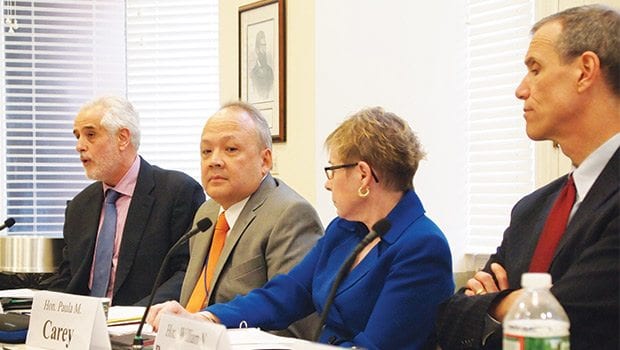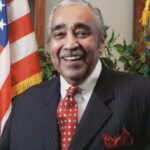Panel convenes on criminal justice reform bill, report and next steps
State legislative, judiciary members talk fees, mandatory minimums, race data

The day after Governor Charlie Baker filed a bill taking up the Council of State Governments’ recommendations on curbing recidivism, the Boston Bar Association gathered a panel of state judicial and legislative members to discuss the CSG report, what’s missing from Baker’s bill and where to go next.
On the web
Harvard Law School Criminal Justice Policy Program: http://cjpp.law.harvard.edu/
Moderated by Dean Andrew Mazzone from the state attorney general’s office, the panel included Sen. William Brownsberger; state Rep. John Fernandes; Paula Carey, chief justice of the state Trial Court; Randy Gioia, deputy chief counsel of the public defender division of the state’s Committee for Public Counsel Services; Jack Lu, Massachusetts Superior Court associate justice and Sentencing Commission chair; Michael O’Keefe, Cape and Island district attorney; and Lon Povich, the governor’s chief legal counsel.
Baker’s bill
The governor’s bill seeks to encourage participation in programs aimed at preparing incarcerated or recently released individuals for reentry into society. The bill would allow those on parole to earn time off of their supervision and for those incarcerated under certain mandatory minimum sentences to earn “good time” (e.g., time deducted from a prisoner’s sentence for good behavior). The bill also permits good time to be earned from programs with shorter durations.
Missing pieces
Many activists have raised alarm over the CSG’s failure to address racial disparities or the sources of initial incarceration. Several panelists said a wider scope would have been too unwieldy but that now is the time for filing bills that follow up where the CSG report and governor’s bill left off.
Among items legislators have proposed: ending mandatory minimums for nonviolent drug offenses, expunging juvenile criminal records, allowing one to be considered “juvenile” until age 21 and setting bail based on the accused’s flight risk and level of public safety threat, not financial ability.
Several panelists spoke of modernizing the state’s sentencing guidelines, which were published first in the 1990s. For instance, Gioia said, best practices research since then reveals that shorter probation periods can be equally effective.
Brownsberger and Povich said collateral consequences on incarceration, such as fines, fees and lingering public criminal records, create burdens and barriers to successful reentry and need to be addressed legislatively.
Calvin Feliciano, a criminal justice reform activist who was incarcerated in his youth, recalled during a Banner phone interview that he once turned to selling drugs post-release in order to afford probation fees and court fees. If he missed payment, he could have been returned to jail.
Returning to the workforce after years of absence is hard enough, without fees and trips to probation officer meetings placing an additional burden, Feliciano said. Job placement and training programs can help, he said, as can reforming the fines system.
Feliciano also said that he knows others who have participated in a “fine time” program in which they voluntarily incarcerate themselves in order to earn daily credit toward fees. In 2016, The Boston Globe reported a sampling of statewide cases revealed more than 100 instances of fine time jailing, under which participants earned $30 per day.
“I’ve seen people do as much as 80 days they didn’t have to in order to pay fines,” Feliciano said. The state then shoulders both the cost of incarceration and per diem payment, which eventually are paid by taxpayers.
Feliciano is among those advocating for felonies to be expunged from criminal records after seven years, not ten, and misdemeanors to be removed after three years, not five. He also says the felony threshold should be raised from $250.
A member from the advocacy group the Coalition for Effective Public Safety attended the event, and spoke from the audience about her coalition’s January letter calling for reforms. These included presumptive parole, diversion programs, bail reform and other measures.
Mandatory minimums
Panelists were split over mandatory minimum policy. Gioia noted that as the number of offenses triggering mandatory minimums proliferated from one to hundreds between 1978 and today, incarceration rates rose four to five times, suggesting reforms could have a significant impact on reducing prison populations. As of Jan. 1, 2017, those held on mandatory minimum sentences comprised 10 percent of those in the state’s prisons, according to O’Keefe.
Lu proposed updating sentencing guidelines to include more safety valve measures.
In response to a Banner question, Gioia said that the incarceration numbers show only a portion of the impact of mandatory minimum sentences. In his experience, prosecutors, whenever possible, use the prospect of such a charge to coerce defendants into pleading guilty to a lesser offense.
“In my years of practicing, I don’t think I ever saw a prosecutor who didn’t initially charge somebody with a mandatory minimum when they had the opportunity to do it,” Gioia said. “For a person who is initially charged with a mandatory minimum, the options become very, very limited: Go to trial, you’re found guilty, you end up with two, three, five years, or plead guilty to a crime that’s not a mandatory minimum and you’re on one to two years probation. It has a very coercive effect — that’s one of the major problems with mandatory minimums.”
Suffolk County District Attorney Dan Conley told the Banner that he believes defendants only plead guilty out of a desire to own up, not out of fear of a mandatory sentence.
“This is not a compulsion — most of these pleas are done because the defendant asks for leniency,” Conley said.
O’Keefe told the Banner he disputes the concept that there are mandatory minimums for nonviolent drug offenses, saying that any such offense that gets passed onto a court where it would trigger a mandatory minimum is severe enough to represent a public safety threat.
Racial data lacking
Speaking from the audience, Rahsaan Hall, director of the Racial Justice Program of the ACLU of Massachusetts, said that he is concerned about the governor filing and preparing to invest heavily in a criminal justice reform bill that does not touch on the racial disparities inherent in the system.
The CSG report states that insufficiencies in the data collection prevented the team from identifying root causes of racial disparities, only that they exist, and recommends remedial action. Brownsberger said a House bill including mandated racial data collection has languished for years after passing because the executive branch did not act on it. As such, initiating the data collection would not require any new bill filing, just implementing what’s already on the books, Fernandes said.
O’Keefe, however, said there are practical tangles first to unwind, such as how data should be collected. For instance, he said, if police ask those they stop to self-identify their race, that could alarm people.
Harvard Law School, in partnership with the state court system, is expected to study criminal justice system racial disparities and fill in some of pieces missing from the CSG report.
Investment needed
While original plans called for garnering savings from CSG recommendation measures and reinvesting them, panelists said it has become clear that change requires a cash infusion.
The CSG report asks for $3.5 million in the first year to provide for things such as more beds in long-term substance abuse treatment programs, anti-recidivism strategy training for post-release supervision personnel and more programming for prisoners. Panelists said the money has been set aside in this year’s budget. Over six years, the total cost will come to $34.5 million.
Reducing incarceration — unless it is by a level substantial enough to allow a prison wing or facility to be closed — does not translate directly into substantial savings, Brownsberger said. Part of the reason is safety: It can be difficult to close a wing because members of different gangs need to be physically distanced, and inmates need different security levels, he said. As such, overhead and unionized personnel costs may remain about the same. In Fiscal Year 2015, the daily cost of food, clothing, medical care and other necessities amounted $9.95 per prisoner, according to the CSG.
Instead of budget easements, a prison population decline more likely will produce better quality operations — such as fewer prisoners per cell and reduced probation caseloads — and better public safety, Brownsberger said.






